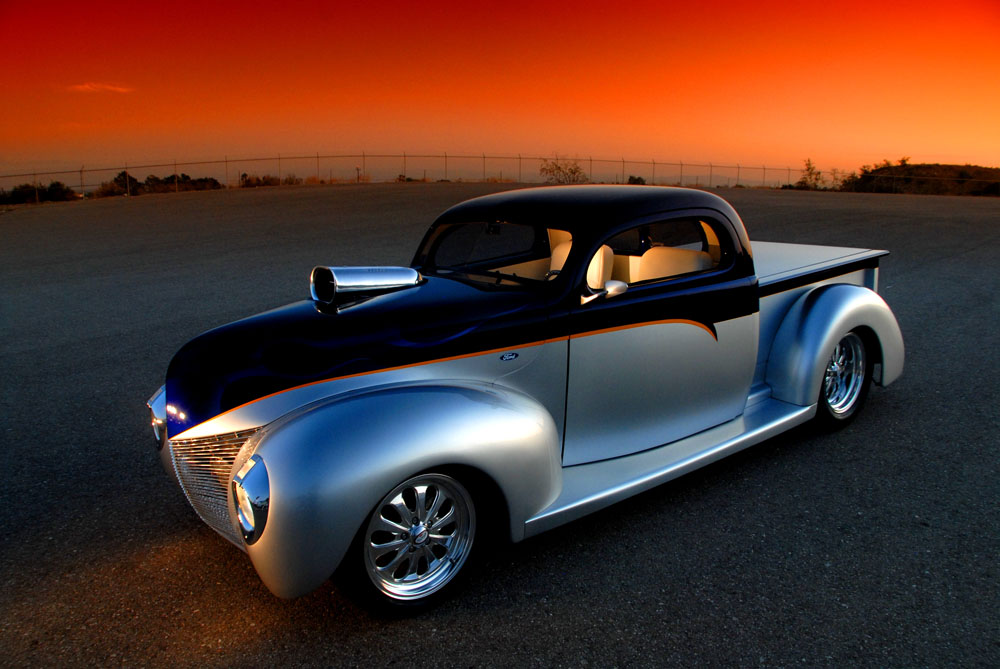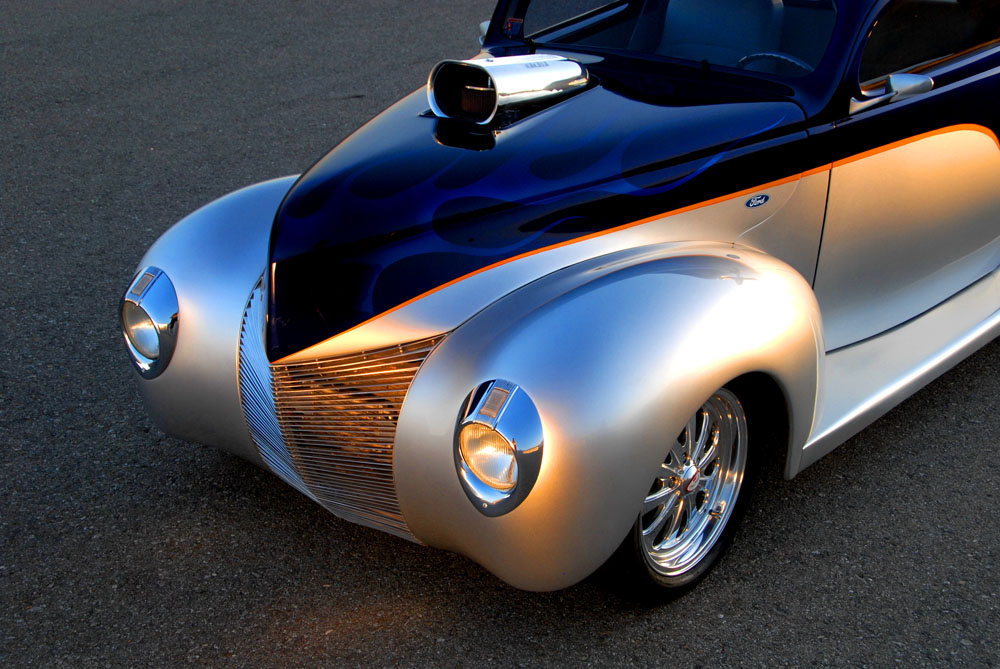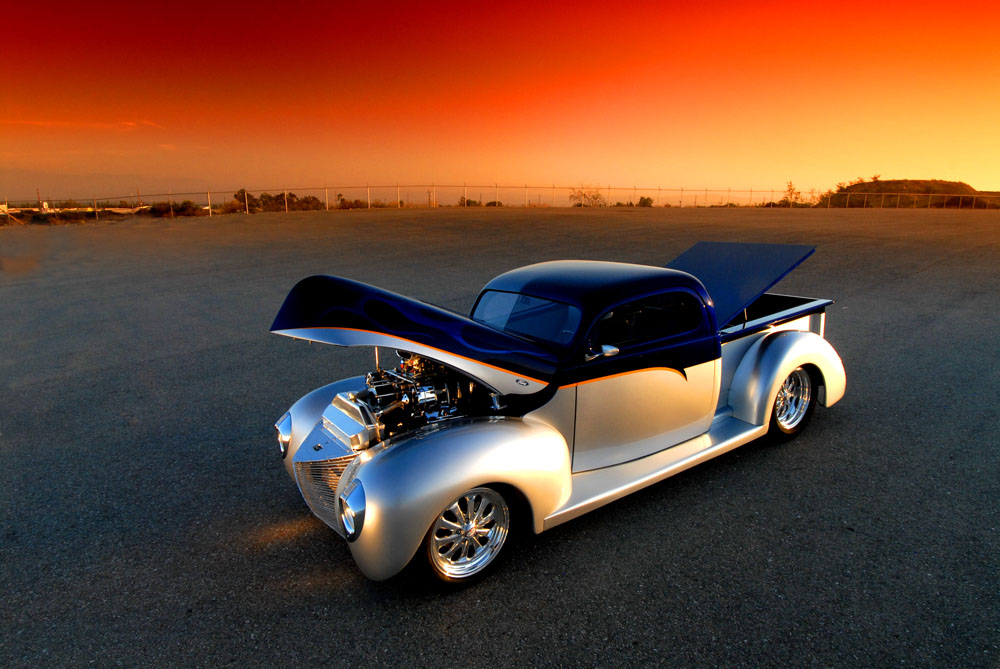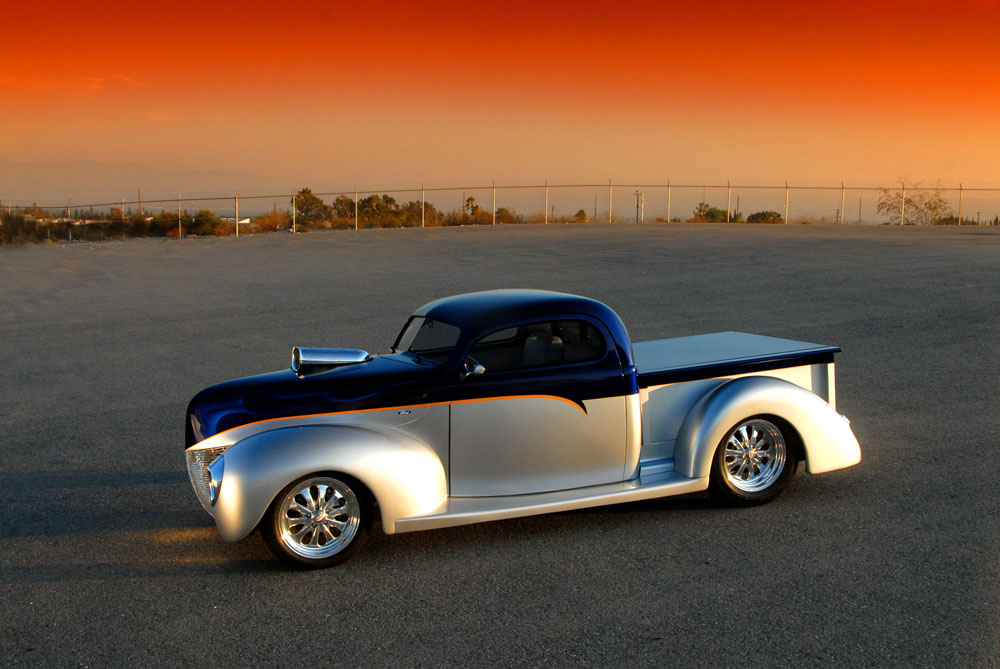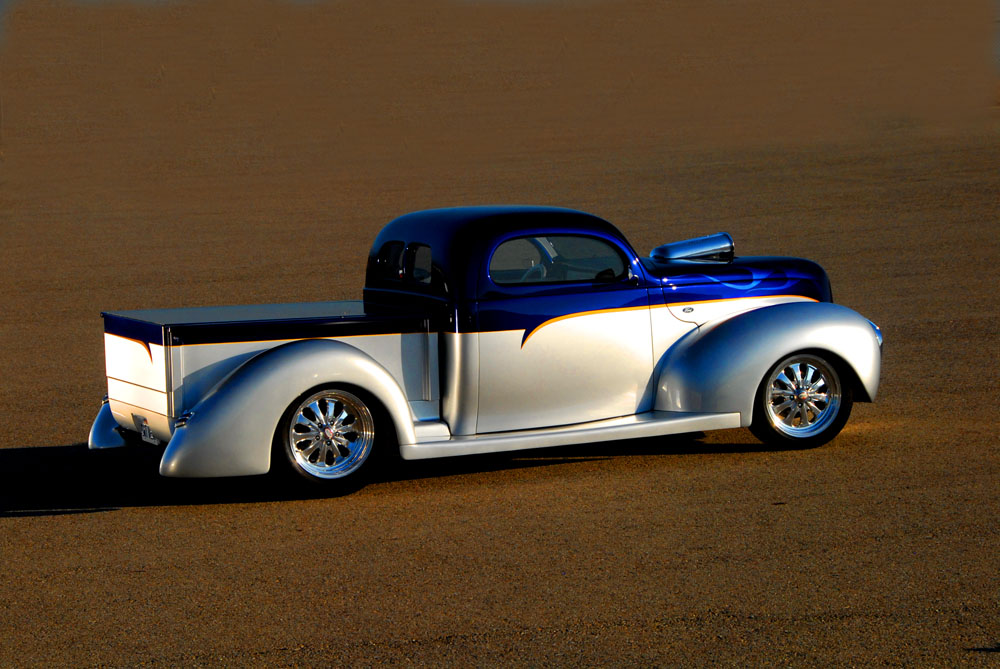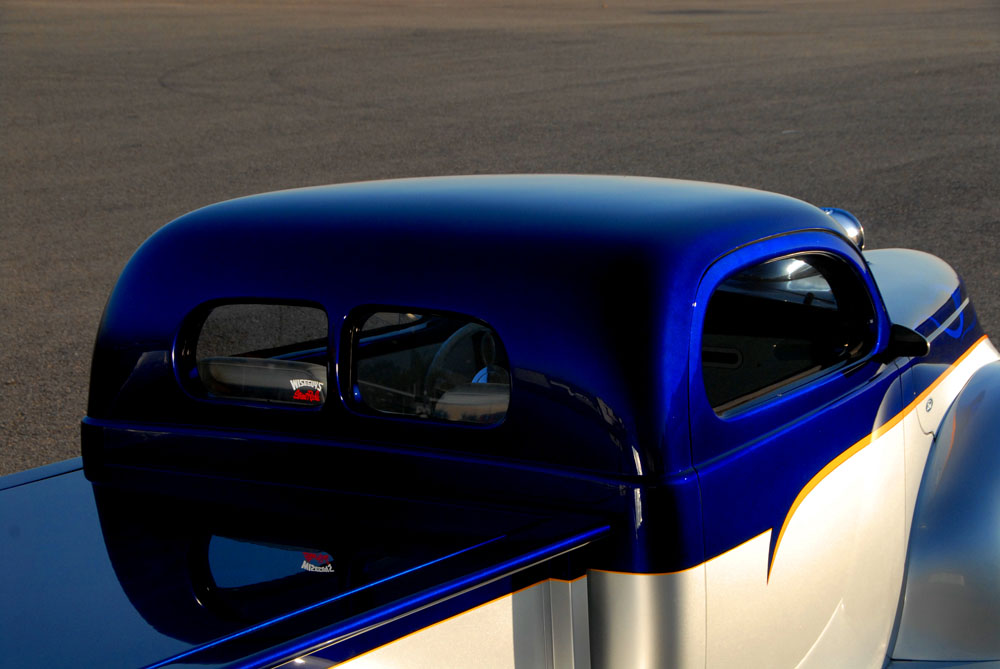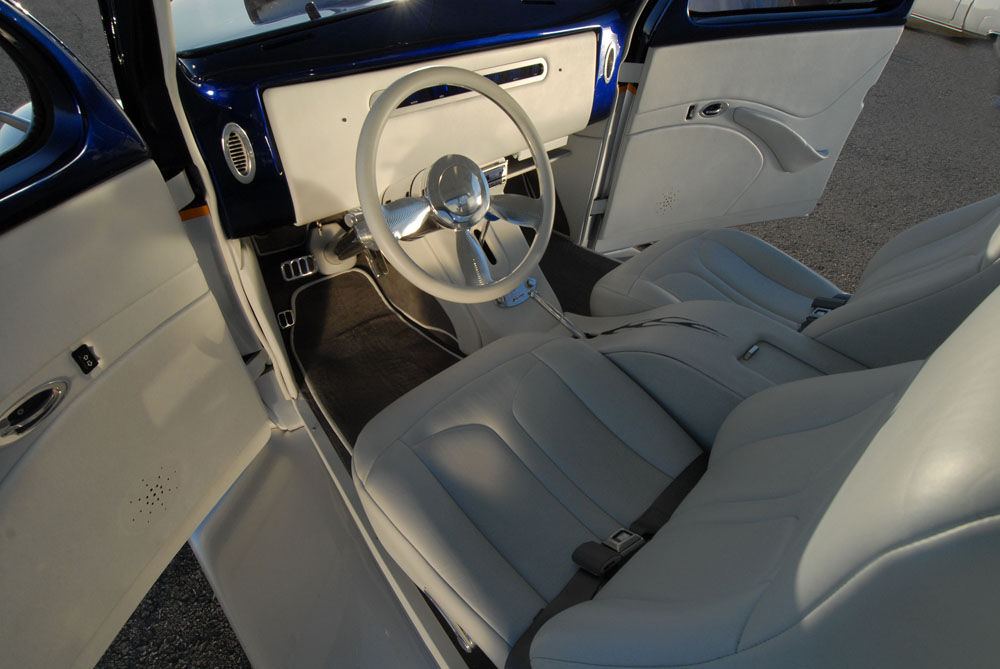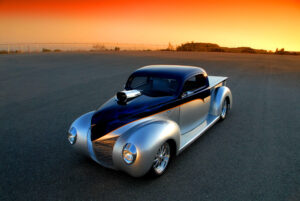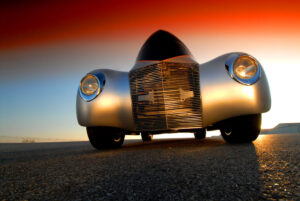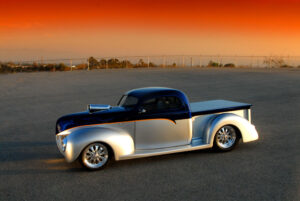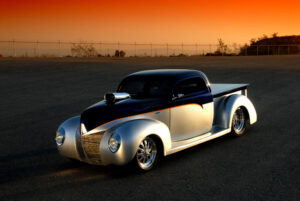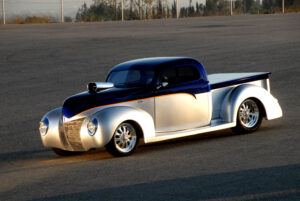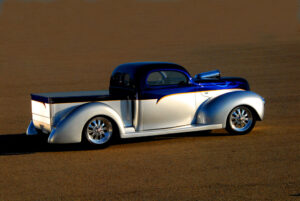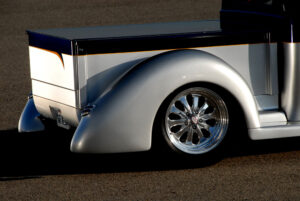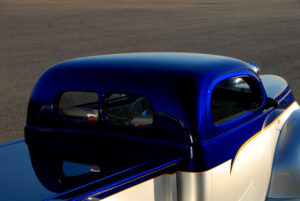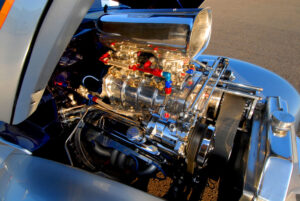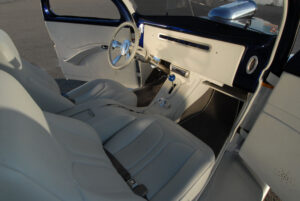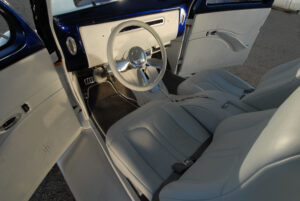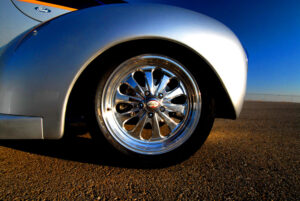Ira is a gentleman hotrodder, and he started with a stock 1940 Ford Pickup. I big Chevy crate motor was a must, with 350 transmissions.. The best black leather with blue inserts dominates the inside of the car. Classic instruments did a great job as possible and so did the House of Colors with their deep blue metallic colors. For me as a photographer, it is such a pleasure to meet such ultimate professionals and for them to give me their time is a great honor. 1937 to 1940 Fords are some of the most popular cars for hot rodding with their cute looks, balanced styling, and endearing front end. They almost wink at you. The pickups are particularly well-proportioned as you can from the photos. And it helps that the color is just so. 1937 to 1940 Fords are some of the most popular cars for hot rodding with their cute looks, balanced styling, and endearing front end. They almost wink at you. The pickups are particularly well-proportioned as you can from the photos. And it helps that the color is just so. However, it was Ford who introduced the first mass-production V8 engine in 1932. Technically Cadillac had one first, but it wasn’t mass-produced in the same numbers. Anyhow the Ford engine was a flathead and this pickup originally had one. 221 cubic inches (3.6 litres) and 85 horsepower. It’s called a flathead because the cylinder heads are flat on top. Pretty straightforward really. The valves are in the block alongside the cylinders and effectively pointing up so the heads are flat. As opposed to an overhead valve engine where the valves are in the cylinder head pointing down. You might wonder why the flathead design didn’t last beyond the ‘50s to today. You probably didn’t but I’ll tell you anyway. That’s because the exhaust ports were located in the V of the engine and hot exhaust gases had to pass through the engine block to exit at the sides. Those hot exhaust gases means that the flathead V8 was hot. It created a high thermal load needing bigger cooling capacity than overhead valve designs. It was prone to hot running and failure without adequate cooling. Especially under load. Like so many projects this was an ambitious goal to make a timeless custom. The top was chopped 2 1/2 inches and received a pie cut. The rain wells have also been smoothed. The hood had 1 1/2 inches taken out and extended 1 inch. The iconic Ford grill was brought forward, but the lower section remained. This gives a more aggressive forward look. The fenders also received a pie cut adding 1 inch to bring them out. The headlights were brought back 1/2 inch for a more streamlined look. Rear driver’s side fender has a custom-built gas tank door. Tailgate is a work of art. The heavy steel gate has the latch on the inside to keep the lines clean. The bed is wood lined with a non- slipcover keeping to a period correct look. One only must look at the door and hood gaps to the level of craftsmanship. Add it to your collection for $86,500.00! The Ford line of cars was updated in 1937 with one major change — the introduction of an entry-level 136 CID (2.2 L) V8 in addition to the popular 221 CID (3.6 L) flathead V8. The model was a refresh of its predecessor, the Model 48 (itself based on the Model 40A), and was the company’s main product. A high flat-topped hood dominated the front look of the 1940 model, as the grille spread out to reach the fenders to differentiate the Deluxe line and the headlights were pushed wider still. The standard Ford inherited the grille of the 1939 model with blackout on each side of a heavy chrome center; heavier headlight surrounds serve as another major differentiator from the 1939. 1940 was the last year of the 1937 design and its smaller V8 engine, with a straight-six engine to be reintroduced the following year. The 1937-1940 generation of Fords is one of the most popular automobiles for hot rodding. Early stock car racing drivers also used Fords of this generation among other cars. This Ford also formed the basis for a style of dirt track racing car.
Ira was a man with a passion for hotrods, and he had always dreamed of creating the perfect custom car. He started with a stock 1940 Ford Pickup, and immediately set to work on transforming it into a timeless classic.
The first thing Ira did was to replace the old flathead engine with a big Chevy crate motor, complete with 350 transmissions. This gave the car the power and performance he needed to take it to the next level.
Next, he turned his attention to the interior, outfitting it with the best white leather he could find. Classic Instruments and House of Colors did an excellent job of providing the finishing touches, with deep blue metallic colors that perfectly complemented the sleek lines of the car.
As a photographer, I had the privilege of watching Ira work, and it was clear that he was a true professional. His attention to detail was second to none, and he was always willing to take the time to show me the ins and outs of his latest project for my camera on location.
The 1937-1940 Fords were some of the most popular cars for hot rodding, and Ira’s pickup was no exception. Its cute looks, balanced styling, and endearing front end were sure to turn heads wherever it went. And the fact that Ira had chosen such a perfect color for the car only added to its allure.
But what really set Ira’s pickup apart was the level of craftsmanship that had gone into its creation. The top had been chopped 2 1/2 inches and received a pie cut, while the rain wells had been smoothed. The hood had 1 1/2 inches taken out and extended 1 inch, and the iconic Ford grill had been brought forward to give the car a more aggressive look.
The fenders had also received a pie cut, adding an inch to bring them out, and the headlights had been brought back 1/2 inch for a more streamlined appearance. The rear driver’s side fender even had a custom-built gas tank door, while the tailgate was a work of art, with the latch on the inside to keep the lines clean.
Even the bed of the pickup had been carefully crafted, with a wood lining and non-slip cover that maintained a period-correct look. And the door and hood gaps were so precise that you could tell that Ira had put his heart and soul into every inch of the car.
In the end, Ira’s pickup was a true masterpiece, and it was clear that he had poured his heart and soul into its creation. And while it wasn’t cheap, with a price tag of $86,500.00, it was worth every penny to anyone who appreciated the timeless beauty of a classic hotrod.

